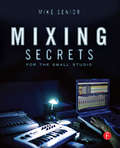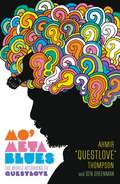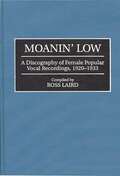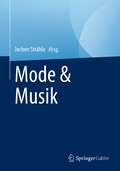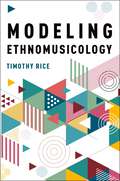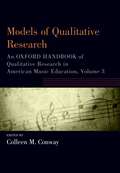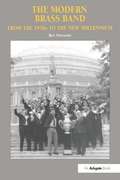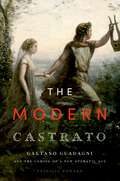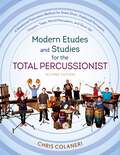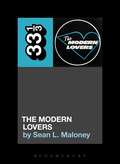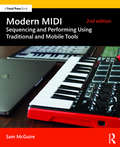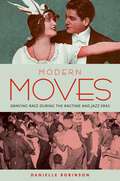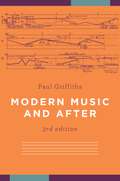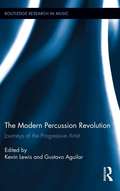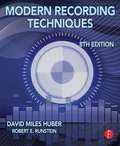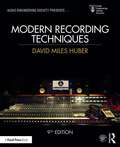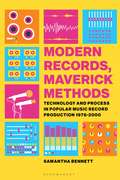- Table View
- List View
Mixing Secrets For The Small Studio (PDF)
by Mike SeniorDiscover how to achieve release-quality mixes even in the smallest studios by applying power-user techniques from the world's most successful producers. Mixing Secrets For The Small Studio is a down-to-earth primer for small-studio enthusiasts who want chart-ready sonics in a hurry. Drawing on the back-room strategies of more than 100 famous names, this entertaining guide leads you step-by-step through the entire mixing process. On the way, you'll unravel the mysteries of every type of mix processing, from simple EQ and compression through to advanced spectral dynamics and 'fairy dust' effects. User-friendly explanations introduce technical concepts on a strictly need-to-know basis, while chapter summaries and assignments are perfect for school and college use. * Learn the subtle editing, arrangement, and monitoring tactics which give industry insiders their competitive edge, and master the psychological tricks which protect you from all the biggest rookie mistakes. * Find out where you don't need to spend money, as well as how to make a limited budget really count. * Pick up tricks and tips from leading-edge engineers working on today's multi-platinum hits, including Michael Brauer, Serban Ghenea, the Lord-Alge brothers, Tony Maserati, Manny Marroquin, Dave 'Hard Drive' Pensado, Jack Joseph Puig, Mark 'Spike' Stent, Phil Tan, Andy Wallace, and many, many more... Mike Senior is a professional engineer who has worked with Wet Wet Wet, The Charlatans, Reef, Therapy, and Nigel Kennedy. He specialises in adapting the techniques of top producers for those working on a budget. Since 2007 he has transformed dozens of amateur productions for Sound On Sound magazine's popular 'Mix Rescue' column, proving time and again that you can achieve commercial-grade results with affordable gear -- once you know how!
Mo' Meta Blues: The World According to Questlove
by Ahmir "Questlove" Thompson Ben Greenman"You have to bear in mind that [Questlove] is one of the smartest motherf*****s on the planet. His musical knowledge, for all practical purposes, is limitless." --Robert Christgau A punch-drunk memoir in which Everyone's Favorite Questlove tells his own story while tackling some of the lates, the greats, the fakes, the philosophers, the heavyweights, and the true originals of the music world. He digs deep into the album cuts of his life and unearths some pivotal moments in black art, hip hop, and pop culture. Ahmir "Questlove" Thompson is many things: virtuoso drummer, producer, arranger, Late Night with Jimmy Fallon bandleader, DJ, composer, and tireless Tweeter. He is one of our most ubiquitous cultural tastemakers, and in this, his first book, he reveals his own formative experiences--from growing up in 1970s West Philly as the son of a 1950s doo-wop singer, to finding his own way through the music world and ultimately co-founding and rising up with the Roots, a.k.a., the last hip hop band on Earth. Mo' Meta Blues also has some (many) random (or not) musings about the state of hip hop, the state of music criticism, the state of statements, as well as a plethora of run-ins with celebrities, idols, and fellow artists, from Stevie Wonder to KISS to D'Angelo to Jay-Z to Dave Chappelle to...you ever seen Prince roller-skate?!? But Mo' Meta Blues isn't just a memoir. It's a dialogue about the nature of memory and the idea of a post-modern black man saddled with some post-modern blues. It's a book that questions what a book like Mo' Meta Bluesreally is. It's the side wind of a one-of-a-kind mind. It's a rare gift that gives as well as takes.It's a record that keeps going around and around.
Moanin' Low: A Discography of Female Popular Vocal Recordings, 1920-1933 (Discographies: Association for Recorded Sound Collections Discographic Reference)
by Ross LairdThe first comprehensive guide to pre-1934 female popular vocal recordings sung in English—from around the world and including all styles—this discographical study includes solos, duets, trios, and quartets composed by the great songwriters of the early 1900s (from Irving Berlin to Victor Young). The majority of the listings includes material that has not been previously published, and a large number of entries profile such prolific artists as Helen Clark and Gladys Rice, who are not in previous discographies. A special feature includes data on sound-on-disc recording made for early talking-picture musical shorts (especially by Vitaphone) that is not documented elsewhere. A comprehensive title index includes composer credits for the majority of the titles listed.The first comprehensive guide to pre-1934 female popular vocal recordings sung in English—from around the world and including all styles—this discographical study includes solos, duets, trios, and quartets composed by the great songwriters of the early 1900s (from Irving Berlin to Victor Young). The majority of the listings includes material that has not been previously published, and a large number of entries profile such prolific artists as Helen Clark and Gladys Rice, who are not in previous discographies. A special feature includes data on sound-on-disc recording made for early talking-picture musical shorts (especially by Vitaphone) that is not documented elsewhere. A comprehensive title index includes composer credits for the majority of the titles listed.Many of the records documented in this volume are by the artists who introduced these songs at this time or who performed them in the original productions of the shows or movies for which they were written. The singing styles include those of cabaret performers, music-hall and vaudeville acts. Songs for the stage, screen, and radio are also included.
Mode & Musik
by Jochen SträhleDieses Buch wird das Verständnis der Leser für die Verbindungen zwischen der Musik- und der Modeindustrie erweitern. Es hebt die Herausforderungen hervor, denen sich die Modeindustrie derzeit in Bezug auf den Hyperwettbewerb, die Definition immer schnellerer Trends, sich ändernde Verbraucherwünsche usw. gegenübersieht. Die Modeindustrie wird in der Tat stark von der digitalen Revolution in der Musikindustrie beeinflusst, die das Gesicht des individuellen Musikkonsums und des sozialen Bezugs verändert hat und sich daher auch auf den Modekonsum und den sozialen Bezug auswirkt. Dieses Verständnis ist von entscheidender Bedeutung, um die Strategien eines Modeunternehmens auf die Anforderungen der modernen Modekonsumenten auszurichten. Inhaltlich befasst sich das Buch zunächst mit der sozialen Perspektive von Mode und Musik. Dazu gehört eine Analyse der Musik als wichtiger Einflussfaktor für Modetrends, sowohl theoretisch als auch anhand einer Fallstudie über Grunge-Musik. Anschließend wird die Rolle der Musik in der Modebranche behandelt, wobei die Musik in den Geschäften und die Rolle der Musik in der Modekommunikation behandelt werden. Im Anschluss daran wird die Rolle der Mode im Musikgeschäft analysiert. Dazu gehören der Trend zum Co-Design von Modekollektionen, die Rolle von Musikkünstlern bei der Differenzierung nach Stilrichtungen und der Markt für Musik-Mode-Merchandise-Artikel (sowohl theoretisch als auch anhand einer Fallstudie). Abschließend werden mögliche Lehren aus der Musikindustrie für die Modeindustrie gezogen. Dazu gehört auch eine Analyse der digitalen Revolution und des Aufkommens der Crowdfunding-Idee (sowohl theoretisch als auch in einer Fallstudie).
Modeling Ethnomusicology
by Timothy RiceEthnomusicology is an academic discipline with a very broad mandate: to understand why and how human beings are musical through the study of music in all its geographical and historical diversity. Ethnomusicological scholarship, however, has been remiss in articulating such goals, methods, and theories. A renowned figure in the field, Timothy Rice is one of the few scholars to regularly address this problem. In this volume, he offers a compilation of essays drawn from across his career that finds implicit and yet largely unrecognized patterns unifying ethnomusicology over its recent history. Modeling Ethnomusicology summarizes thirty years of thinking about the field of ethnomusicology as Rice frames and reframes the content of eight of his most important essays from their original context in relation to the environment of today's ethnomusicology. Rice proposes a variety of models meant to guide students and researchers in their study of ethnomusicology. Some of these models pull together disparate strands of the field, while others propose heuristic models that generate questions for researchers as they plan and conduct their research. A new introduction to these essays reviews the history of his writing about ethnomusicology and proposes an innovative model for theorizing in ethnomusicology by ethnomusicologists. This book will be an enduring, essential text in undergraduate and graduate ethnomusicology classrooms, as well as a must-buy for established scholars in the field.
MODELING ETHNOMUSICOLOGY C
by Timothy RiceEthnomusicology is an academic discipline with a very broad mandate: to understand why and how human beings are musical through the study of music in all its geographical and historical diversity. Ethnomusicological scholarship, however, has been remiss in articulating such goals, methods, and theories. A renowned figure in the field, Timothy Rice is one of the few scholars to regularly address this problem. In this volume, he offers a compilation of essays drawn from across his career that finds implicit and yet largely unrecognized patterns unifying ethnomusicology over its recent history. Modeling Ethnomusicology summarizes thirty years of thinking about the field of ethnomusicology as Rice frames and reframes the content of eight of his most important essays from their original context in relation to the environment of today's ethnomusicology. Rice proposes a variety of models meant to guide students and researchers in their study of ethnomusicology. Some of these models pull together disparate strands of the field, while others propose heuristic models that generate questions for researchers as they plan and conduct their research. A new introduction to these essays reviews the history of his writing about ethnomusicology and proposes an innovative model for theorizing in ethnomusicology by ethnomusicologists. This book will be an enduring, essential text in undergraduate and graduate ethnomusicology classrooms, as well as a must-buy for established scholars in the field.
Models of Qualitative Research: An Oxford Handbook of Qualitative Research in American Music Education, Volume 3 (Oxford Handbooks)
by Colleen M. ConwayNew in paperback, the articles collected in Models of Qualitative Research examine the use of qualitative research in answering important research questions regarding music teaching and learning in a variety of diverse music education contexts. Each author examines key studies and provides suggestions for future questions that qualitative researchers may consider. Contexts examined in the chapter include: early childhood music, general music, instrumental music -winds, brass percussion, instrumental music-strings, choral music, preservice teacher education, teacher professional development, community music education, music for students with special needs, music education and issues of diversity, and world music. Models of Qualitative Research is the third of three paperback volumes derived from the original Oxford Handbook of Qualitative Research in American Music Education, which outlines the history of qualitative research in music education and explores the contemporary use of qualitative approaches in examining issues related to music teaching and learning.
Models of Qualitative Research: An Oxford Handbook of Qualitative Research in American Music Education, Volume 3 (Oxford Handbooks)
New in paperback, the articles collected in Models of Qualitative Research examine the use of qualitative research in answering important research questions regarding music teaching and learning in a variety of diverse music education contexts. Each author examines key studies and provides suggestions for future questions that qualitative researchers may consider. Contexts examined in the chapter include: early childhood music, general music, instrumental music -winds, brass percussion, instrumental music-strings, choral music, preservice teacher education, teacher professional development, community music education, music for students with special needs, music education and issues of diversity, and world music. Models of Qualitative Research is the third of three paperback volumes derived from the original Oxford Handbook of Qualitative Research in American Music Education, which outlines the history of qualitative research in music education and explores the contemporary use of qualitative approaches in examining issues related to music teaching and learning.
The Modern Castrato: Gaetano Guadagni and the Coming of a New Operatic Age
by Patricia HowardThe Modern Castrato: Gaetano Guadagni and the Coming of a New Operatic Age chronicles the career of the most significant castrato of the second half of the eighteenth-century. Through a coincidence of time and place, Gaetano Guadagni was on the forefront of the heroic opera reform, and many forward-thinking composers of the age created roles for him. Author Patricia Howard reveals that Guadagni may have been the only singer of the time fully able to understand the demands and opportunities of this reform, as well to possess the intelligence and self-knowledge to realize that it suited his skills, limitations and temperament perfectly--making him the first castrato to embrace the concepts of modern singing. The first full-length biography of this outstanding singer, The Modern Castrato illuminates the everyday lives of eighteenth-century singers while spotlighting the historic high points of the century. Most famous for his creation of the role of Orpheus in Gluck's Orfeo ed Euridice, his career ranged widely and brought him into contact with many progressives theorists and composers such as Traetta, Jommelli, and Bertoni. Howard's focus on the development of Guadagni's career pauses on essential, related topics along the way, such as the castrato in society, the eighteenth-century revolution in acting, and the remarkable evidence for Guadagni's marionette theater. Howard also assesses Guadagni's surviving compositions, which give new insight into the quality and character of his voice as well as his technical and expressive abilities. The Modern Castrato is an engaging narrative that will prove essential reading for opera lovers and scholars of eighteenth-century music.
The Modern Castrato: Gaetano Guadagni and the Coming of a New Operatic Age
by Patricia HowardThe Modern Castrato: Gaetano Guadagni and the Coming of a New Operatic Age chronicles the career of the most significant castrato of the second half of the eighteenth-century. Through a coincidence of time and place, Gaetano Guadagni was on the forefront of the heroic opera reform, and many forward-thinking composers of the age created roles for him. Author Patricia Howard reveals that Guadagni may have been the only singer of the time fully able to understand the demands and opportunities of this reform, as well to possess the intelligence and self-knowledge to realize that it suited his skills, limitations and temperament perfectly--making him the first castrato to embrace the concepts of modern singing. The first full-length biography of this outstanding singer, The Modern Castrato illuminates the everyday lives of eighteenth-century singers while spotlighting the historic high points of the century. Most famous for his creation of the role of Orpheus in Gluck's Orfeo ed Euridice, his career ranged widely and brought him into contact with many progressives theorists and composers such as Traetta, Jommelli, and Bertoni. Howard's focus on the development of Guadagni's career pauses on essential, related topics along the way, such as the castrato in society, the eighteenth-century revolution in acting, and the remarkable evidence for Guadagni's marionette theater. Howard also assesses Guadagni's surviving compositions, which give new insight into the quality and character of his voice as well as his technical and expressive abilities. The Modern Castrato is an engaging narrative that will prove essential reading for opera lovers and scholars of eighteenth-century music.
Modern Etudes and Studies for the Total Percussionist
by Chris ColaneriIn Modern Etudes and Studies for the Total Percussionist, band director and percussionist Chris Colaneri lays out a comprehensive system of total percussion education. The lessons are gleaned from interviews, research, and the nearly two decades he has spent directing middle school band and percussion ensembles. This expanded second edition meets needs of fourth grade through high school percussion students, helping them develop necessary skills for future participation in their next level of musical study or extracurricular performing ensembles. Developed with the practical needs of percussion teachers in mind, Modern Etudes has been extensively classroom tested and provides key teaching aids that will be welcomed by every band director. These include a curriculum guide and practice assignment sheets for all grades; practice tips; and exercises and etudes for snare, mallet, set, and timpani. Recordings, practice tracks, and videos are available on the book's companion website.
The Modern Lovers' The Modern Lovers (33 1/3)
by Sean L. MaloneyFrom the "War on Hippies" to the Great Rock 'n' Roll Swindle, the story of Modern Lovers is a high octane tale of Brutalist architecture, rock 'n' roll ambition and the struggle for identity in a changing world. One of punk rock's foundational documents, the archetype for indie obsession and all but disowned by its author, The Modern Lovers was an album doomed by its own coolness from day one. Powered by the two-chord wonder "Roadrunner†? and its proclamation that "I'm in love with rock 'n' roll,†?The Modern Lovers is the essential document of American alienation, an escape route from the cultural wasteland of postwar suburbia. The Modern Lovers is the bridge connecting the Velvet Underground and the Sex Pistols; they were peers of the New York Dolls and friends with Gram Parsons and they would splinter into Talking Heads, The Cars, and The Real Kids. But The Modern Lovers was never meant to be an album. A collection of demos, recorded in fits and starts as Jonathan Richman and his band negotiate modernity and the music industry. It is a collection of songs about a city and a society in flux, grappling with ancient corruptions and bright-eyed idealism. Richman observes a city all but abandoned by adults, ravaged by white flight and urban renewal, veering towards anarchy as old world social moors collide with new attitudes. It is a city stands in stark contrast to the the ranchstyle bedroom community where he was raised. All of these conflicts are churned through Richman's intellectual acuity and emotional unrest to create one of the 20th century's most enduring documents of post-adolescent malaise.
The Modern Lovers' The Modern Lovers (33 1/3)
by Sean L. MaloneyFrom the "War on Hippies" to the Great Rock 'n' Roll Swindle, the story of Modern Lovers is a high octane tale of Brutalist architecture, rock 'n' roll ambition and the struggle for identity in a changing world. One of punk rock's foundational documents, the archetype for indie obsession and all but disowned by its author, The Modern Lovers was an album doomed by its own coolness from day one. Powered by the two-chord wonder “Roadrunner” and its proclamation that “I'm in love with rock 'n' roll,”The Modern Lovers is the essential document of American alienation, an escape route from the cultural wasteland of postwar suburbia. The Modern Lovers is the bridge connecting the Velvet Underground and the Sex Pistols; they were peers of the New York Dolls and friends with Gram Parsons and they would splinter into Talking Heads, The Cars, and The Real Kids. But The Modern Lovers was never meant to be an album. A collection of demos, recorded in fits and starts as Jonathan Richman and his band negotiate modernity and the music industry. It is a collection of songs about a city and a society in flux, grappling with ancient corruptions and bright-eyed idealism. Richman observes a city all but abandoned by adults, ravaged by white flight and urban renewal, veering towards anarchy as old world social moors collide with new attitudes. It is a city stands in stark contrast to the the ranchstyle bedroom community where he was raised. All of these conflicts are churned through Richman's intellectual acuity and emotional unrest to create one of the 20th century's most enduring documents of post-adolescent malaise.
Modern MIDI: Sequencing and Performing Using Traditional and Mobile Tools
by Sam McGuireModern MIDI equips you with everything you need to use MIDI in your music productions. With a particular focus on practical application and step-by-step explanations, this book does far more than tell you about how MIDI works. Simple explanations and real-world scenarios encourage you to test out the techniques for yourself. The second edition of Modern MIDI builds on the first, making sequencing approachable for absolute beginners, reinforcing the fundamentals of MIDI and expanding the coverage into new mobile technology and vintage gear. Modern MIDI is essential reading for beginners from all backgrounds, including students and professionals, as well as experienced users looking to develop their existing setups.
Modern MIDI: Sequencing and Performing Using Traditional and Mobile Tools
by Sam McGuireModern MIDI equips you with everything you need to use MIDI in your music productions. With a particular focus on practical application and step-by-step explanations, this book does far more than tell you about how MIDI works. Simple explanations and real-world scenarios encourage you to test out the techniques for yourself. The second edition of Modern MIDI builds on the first, making sequencing approachable for absolute beginners, reinforcing the fundamentals of MIDI and expanding the coverage into new mobile technology and vintage gear. Modern MIDI is essential reading for beginners from all backgrounds, including students and professionals, as well as experienced users looking to develop their existing setups.
Modern Moves: Dancing Race during the Ragtime and Jazz Eras
by Danielle RobinsonModern Moves traces the movement of American social dance styles between black and white cultural groups and between immigrant and migrant communities during the early twentieth century. Its central focus is New York City, where the confluence of two key demographic streams - an influx of immigrants from Eastern Europe and the growth of the city's African American community particularly as it centered Harlem - created the conditions of possibility for hybrid dance forms like blues, ragtime, ballroom, and jazz dancing. Author Danielle Robinson illustrates how each of these forms came about as the result of the co-mingling of dance traditions from different cultural and racial backgrounds in the same urban social spaces. The results of these cross-cultural collisions in New York City, as she argues, were far greater than passing dance trends; they in fact laid the foundation for the twentieth century's social dancing practices throughout the United States. By looking at dance as social practice across conventional genre and race lines, this book demonstrates that modern social dancing, like Western modernity itself, was dependent on the cultural production and labor of African diasporic peoples -- even as they were excluded from its rewards. A cornerstone in Robinson's argument is the changing role of the dance instructor, which was transformed from the proprietor of a small-scale, local dance school at the end of the nineteenth century to a member of a distinct, self-identified social industry at the beginning of the twentieth. Whereas dance studies has been slow to connect early twentieth century dancing with period racial politics, Modern Moves departs radically from prior scholarship on the topic, and in so doing, revises social and African American dance history of this period. Recognizing the rac(ial)ist beginnings of contemporary American social dancing, it offers a window into the ways that dancing throughout the twentieth century has provided a key means through which diverse groups of people have navigated shifting socio-political relations through their bodily movement. Modern Moves asserts that the social practice of modern dancing, with its perceived black origins, empowered displaced people such as migrants and immigrants to grapple with the effects of industrialization, urbanization, and the rise of North American modernity. Far more than simple appropriation, the selling and practicing of "black" dances during the 1910s and 1920s reinforced whiteness as the ideal racial status in America through embodied and rhetorical engagements with period black stereotypes.
MODERN MOVES C: Dancing Race during the Ragtime and Jazz Eras
by Danielle RobinsonModern Moves traces the movement of American social dance styles between black and white cultural groups and between immigrant and migrant communities during the early twentieth century. Its central focus is New York City, where the confluence of two key demographic streams - an influx of immigrants from Eastern Europe and the growth of the city's African American community particularly as it centered Harlem - created the conditions of possibility for hybrid dance forms like blues, ragtime, ballroom, and jazz dancing. Author Danielle Robinson illustrates how each of these forms came about as the result of the co-mingling of dance traditions from different cultural and racial backgrounds in the same urban social spaces. The results of these cross-cultural collisions in New York City, as she argues, were far greater than passing dance trends; they in fact laid the foundation for the twentieth century's social dancing practices throughout the United States. By looking at dance as social practice across conventional genre and race lines, this book demonstrates that modern social dancing, like Western modernity itself, was dependent on the cultural production and labor of African diasporic peoples -- even as they were excluded from its rewards. A cornerstone in Robinson's argument is the changing role of the dance instructor, which was transformed from the proprietor of a small-scale, local dance school at the end of the nineteenth century to a member of a distinct, self-identified social industry at the beginning of the twentieth. Whereas dance studies has been slow to connect early twentieth century dancing with period racial politics, Modern Moves departs radically from prior scholarship on the topic, and in so doing, revises social and African American dance history of this period. Recognizing the rac(ial)ist beginnings of contemporary American social dancing, it offers a window into the ways that dancing throughout the twentieth century has provided a key means through which diverse groups of people have navigated shifting socio-political relations through their bodily movement. Modern Moves asserts that the social practice of modern dancing, with its perceived black origins, empowered displaced people such as migrants and immigrants to grapple with the effects of industrialization, urbanization, and the rise of North American modernity. Far more than simple appropriation, the selling and practicing of "black" dances during the 1910s and 1920s reinforced whiteness as the ideal racial status in America through embodied and rhetorical engagements with period black stereotypes.
Modern Music and After
by Paul GriffithsOver three decades, Paul Griffiths's survey has remained the definitive study of music since the Second World War; this fully revised and updated edition re-establishes Modern Music and After as the preeminent introduction to the music of our time. The disruptions of the war, and the struggles of the ensuing peace, were reflected in the music of the time: in Pierre Boulez's radical reformation of compositional technique and in John Cage's development of zen music; in Milton Babbitt's settling of the serial system and in Dmitry Shostakovich's unsettling symphonies; in Karlheinz Stockhausen's development of electronic music and in Luigi Nono's pursuit of the universally human, in Iannis Xenakis's view of music as sounding mathematics and in Luciano Berio's consideration of it as language. The initiatives of these composers and their contemporaries opened prospects that haven't yet stopped unfolding. This constant expansion of musical thinking since 1945 has left us with no singular history of music; Griffiths's study accordingly follows several different paths, showing how and why they converge and diverge. This new edition of Modern Music and After discusses not only the music of the fifteen years that have passed since the previous edition, but also the recent explosion of scholarly interest in the latter half of the twentieth century. In particular, the book has been expanded to incorporate the variety of responses to the modernist impasse experienced by composers of the 1980s and 1990s. Griffiths then moves the book into the twenty-first century as he examines such highly influential composers as Helmut Lachenmann and Salvatore Sciarrino. For its breadth, wealth of detail, and characteristic wit and clarity, the third edition of Modern Music and After is required reading for the student and the enquiring listener.
Modern Music and After
by Paul GriffithsOver three decades, Paul Griffiths's survey has remained the definitive study of music since the Second World War; this fully revised and updated edition re-establishes Modern Music and After as the preeminent introduction to the music of our time. The disruptions of the war, and the struggles of the ensuing peace, were reflected in the music of the time: in Pierre Boulez's radical reformation of compositional technique and in John Cage's development of zen music; in Milton Babbitt's settling of the serial system and in Dmitry Shostakovich's unsettling symphonies; in Karlheinz Stockhausen's development of electronic music and in Luigi Nono's pursuit of the universally human, in Iannis Xenakis's view of music as sounding mathematics and in Luciano Berio's consideration of it as language. The initiatives of these composers and their contemporaries opened prospects that haven't yet stopped unfolding. This constant expansion of musical thinking since 1945 has left us with no singular history of music; Griffiths's study accordingly follows several different paths, showing how and why they converge and diverge. This new edition of Modern Music and After discusses not only the music of the fifteen years that have passed since the previous edition, but also the recent explosion of scholarly interest in the latter half of the twentieth century. In particular, the book has been expanded to incorporate the variety of responses to the modernist impasse experienced by composers of the 1980s and 1990s. Griffiths then moves the book into the twenty-first century as he examines such highly influential composers as Helmut Lachenmann and Salvatore Sciarrino. For its breadth, wealth of detail, and characteristic wit and clarity, the third edition of Modern Music and After is required reading for the student and the enquiring listener.
The Modern Percussion Revolution: Journeys of the Progressive Artist (Routledge Research in Music)
by Kevin Lewis Gustavo AguilarMore than eighty years have passed since Edgard Varèse’s catalytic work for percussion ensemble, Ionisation, was heard in its New York premiere. A flurry of pieces for this new medium dawned soon after, challenging the established truths and preferences of the European musical tradition while setting the stage for percussion to become one of the most significant musical advances of the twentieth century. This 'revolution', as John Cage termed it, was a quintessentially modernist movement - an exploration of previously undiscovered sounds, forms, textures, and styles. However, as percussion music has progressed and become woven into the fabric of Western musical culture, several divergent paths, comprised of various traditions and a multiplicity of aesthetic sensibilities, have since emerged for the percussionist to pursue. This edited collection highlights the progressive developments that continue to investigate uncharted musical grounds. Using historical studies, philosophical insights, analyses of performance practice, and anecdotal reflections authored by some of today's most engaged performers, composers, and scholars, this book aims to illuminate the unique destinations found in the artistic journey of the modern percussionist.
The Modern Percussion Revolution: Journeys of the Progressive Artist (Routledge Research in Music)
by Kevin Lewis Gustavo AguilarMore than eighty years have passed since Edgard Varèse’s catalytic work for percussion ensemble, Ionisation, was heard in its New York premiere. A flurry of pieces for this new medium dawned soon after, challenging the established truths and preferences of the European musical tradition while setting the stage for percussion to become one of the most significant musical advances of the twentieth century. This 'revolution', as John Cage termed it, was a quintessentially modernist movement - an exploration of previously undiscovered sounds, forms, textures, and styles. However, as percussion music has progressed and become woven into the fabric of Western musical culture, several divergent paths, comprised of various traditions and a multiplicity of aesthetic sensibilities, have since emerged for the percussionist to pursue. This edited collection highlights the progressive developments that continue to investigate uncharted musical grounds. Using historical studies, philosophical insights, analyses of performance practice, and anecdotal reflections authored by some of today's most engaged performers, composers, and scholars, this book aims to illuminate the unique destinations found in the artistic journey of the modern percussionist.
Modern Recording Techniques
by David Miles Huber Robert E. RunsteinMaster the tools and day-to-day practices of music recording and production. Learn the ins and outs of room acoustics and designing a studio. Gain techniques for mic placement and running a session. Get a solid grounding in both theory and industry practice. Modern Recording Techniques, the bestselling, authoritative guide to recording, provides everything you need to improve your craft. "If you're serious about recording--whether you're an amateur enthusiast, a student, a musician, or an audio professional, you'll find this book an informative, in-depth, cover-to-cover read and a useful reference manual. . . an excellent read and a must-have reference book. " - MusicTech magazine Expanded to include the latest digital audio technology, the eighth edition now has sections on touch technology, tablets, and newer connectivity options, such as Thunderbolt. It also includes revamped graphics throughout, and major updates of the sections covering DAWs, MIDI, and mastering. Whether you are just starting out or are looking for a step-up in the industry, Modern Recording Techniquesprovides an in-depth read on recording; it is a must-have for your audio bookshelf.
Modern Recording Techniques (Audio Engineering Society Presents Series (PDF))
by David Miles Huber Robert E. RunsteinModern Recording Techniques is the bestselling, authoritative guide to sound and music recording. Whether you’re just starting out or are looking for a step-up in the industry, Modern Recording Techniques provides an in-depth read on the art and technologies of music production. It’s a must-have reference for all audio bookshelves. Using its familiar and accessible writing style, this ninth edition has been fully updated, presenting the latest production technologies and includes an in-depth coverage of the DAW, networked audio, MIDI, signal processing and much more. A robust companion website features video tutorials, web-links, an online glossary, flashcards, and a link to the author’s blog. Instructor resources include a test bank and an instructor’s manual. The ninth edition includes: Updated tips, tricks and insights for getting the best out of your studio An introduction to the Apple iOS in music production Introductions to new technologies and important retro studio techniques The latest advancements in DAW systems, signal processing, mixing and mastering
Modern Records, Maverick Methods: Technology and Process in Popular Music Record Production 1978-2000
by Samantha BennettFrom the Fairlight CMI through MIDI to the digital audio workstations at the turn of the millennium, Modern Records, Maverick Methods examines a critical period in commercial popular music record production: the transformative digital age from the late 1970s until 2000. Drawing on a discography of more than 300 recordings across pop, rock, hip hop, dance and alternative musics from artists such as the Beastie Boys, Madonna, U2 and Fatboy Slim, and extensive and exclusive ethnographic work with many world-renowned recordists, Modern Records presents a fresh and insightful new perspective on one of the most significant eras in commercial music record production.The book traces the development of significant music technologies through the 1980s and 1990s, revealing how changing attitudes and innovative techniques of recording personnel reimagined recording processes and, finally, exemplifies the impact of these technologies and techniques via six comprehensive tech-processual analyses. This meticulously researched and timely book reveals the complexity of recordists' responses to a technological landscape in flux.
